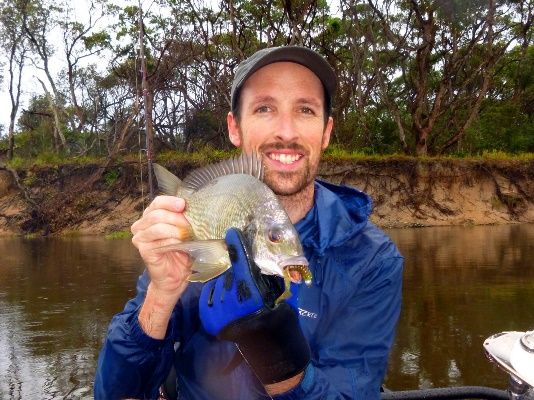Latest News
Flooding rain brings crocodiles to the surface and sends bream down deep
Wednesday, 9 April 2014
The South Coast has been drenched in recent weeks.
During March, Batemans Bay received 160mm, Merimbula 175mm, Ulladulla 223mm, and Jervis Bay a whopping 376mm of rain. These volumes of freshwater flowing into your favourite fishing spot will certainly affect how and where you can catch a fish. But as reports of some big flathead as well as tailor and bream trickle in, it is clear that the fish are still around. Where to find them just seems to vary whether the system is open or closed to the ocean.
Closed lakes & estuaries
I was lucky enough to explore a renowned bream hotspot, Lake Meroo, recently. Less fortunate was that I arrived just a day after 200mm of rain had fallen and it was still coming down. The lake remained stubbornly closed to the ocean and the result was that the car park and vegetation fringing the lake were partially flooded.
My apprehension eased though, and not for the first time I might add, once I launched the Hobie. The lake was stunning, the vegetation mirrored on the water’s surface and it was full of birdlife. I tasted the water on top, it was fresh. That was evidence enough to pedal towards the front in search of deeper, and hopefully saltier, water.
The theory goes that as freshwater floods in from the catchment above, the saltwater is pushed down towards the ‘front’. As saltwater is heavier than fresh it will settle below, attracting fish like flathead, bream and tailor into the deeper water.
The theory seemed to work. I crossed paths with a few of the bream that Lake Meroo is famous for, all caught in 2.5 to 5 metres of water. The best technique was hopping small soft plastics slowly across the bottom on a light jig head - around 1/16th ounce (1.8 grams). Even fishing slowly, a smear with a scent attractant seemed to really help the fish find the lure. My guess is that they were relying more on smell and taste than visual cues in the murky water. Bait fisherman should do well in this scenario.
Open lakes, estuaries and rivers
On the same weekend, Canberra angler Liam Curtis was fishing at Lake Conjola near Ulladulla. In contrast to Lake Meroo, Conjola had just been opened to the sea with an excavator to allow the same 200mm deluge to escape. Wading in the shallows around the new entrance Liam landed a 92cm flathead in just 30cms of water. It walloped a small surface popper intended for a whiting. Big flathead like this are affectionately known as ‘crocodiles’ as their heads are roughly the same size.
He landed five more flathead in the shallows ranging from 50-75cm on a well-chosen Rapala XR6. Three other ‘crocodiles’ around a meter long took off in front of him as he (carefully) waded along. Clearly there were fish everywhere!
In systems that are open to the ocean, the tide can have a dramatic effect on water clarity and fish movement after heavy rains. On an outgoing tide, fish will generally head towards the entrance and even out onto adjacent beaches and headlands seeking respite from the discoloured fresh water.
Or as Liam discovered, as the tide turns and comes back in, cleaner saltwater from the ocean will fill the lower parts of the estuary bringing fish back in with it. If you get the chance, try fishing the line between the discoloured and clean water. Baitfish will hide in the safety of the murky water and predators are sure to be in hot pursuit. Did I mention Liam also caught a tailor on nearly every cast for half an hour?
With more rain forecast, focus your fishing on the lower reaches of the lakes and rivers. Fish in the deeper holes in closed lakes or around the entrance for the open ones. Try fishing slowly with scented lures or with bait - despite appearances there’s still some great fish around.
See you on the flats!
Graham Fifield
Flickandflyjournal.com



